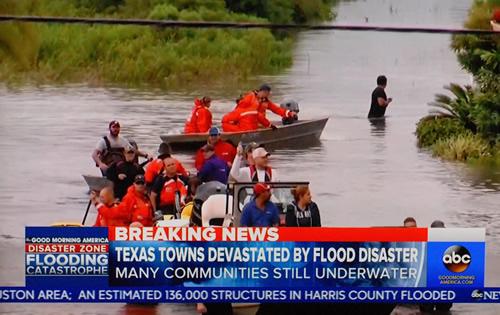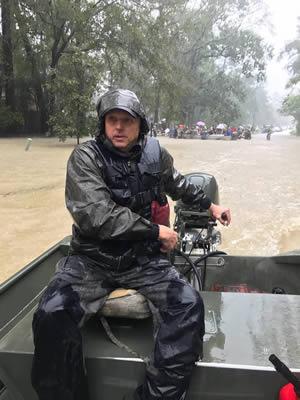September 6, 2017 - There's an old saying among fishermen that you don't necessarily need the biggest boat on the water to catch the biggest fish. In fact, there are times when a small rig like an aluminum jon boat can definitely be better.
Way better.
That's because smaller boats are, well, smaller. This makes it easier to get around so you can quietly maneuver in and out of the tight spots where the biggest fish in the lake sometimes like to hang out. Another advantage is they are lightweight enough to be dragged over logs and other obstructions if the need arises.
In the wake of Hurricane Harvey, it's safe to say little boats are quite capable of accomplishing results that are way bigger that anything to be reeled in on a fishing line.
Harvey was a monster storm that slammed the middle Texas Coast on Aug. 25 with Category 4 winds and a vicious storm surge that reduced the fishing towns of Rockport and Port Aransas to rubble before meeting up with a freaky high pressure system that caused it do something dangerously weird, just as meteorologists had predicted it would.
Rather than continuing on a northward track, the massive storm stalled for several days right on top of southeast Texas where it dumped apocalyptic amounts of rain and caused unprecedented flooding in numerous counties.

Houston - nation's fourth largest city - recorded more than 43 inches and nearby Cedar Bayou saw a staggering 52 inches. A deluge of 47.35 inches swallowed up neighboring Port Arthur and Beaumont in a liquid blanket that nixed water supplies and killed electricity for miles.
The water rose so quickly, and with such force, that it trapped tens of thousands of people in houses, apartments, businesses, cars or wherever else they were at before realizing it was too late to get out. Some found safety on upper floors or pitched tents on roof tops, but others weren't so lucky. At last count the human death toll related to the storm had risen to 46. Countless pets and livestock likely perished, as well.
In the midst of all the crippling chaos is when the little metal boats - mostly 12-16 footers powered by small outboards or various other engine styles favored for shallow water - came pouring in at a mach rate.
There were armies of them, many hitched to tall trucks driven by blue collar folks whose big hearts and unselfish attitudes compelled them to risk their own equipment and personal safety to aid city, state and federal emergency personnel crews that in no way were a match for an unfolding disaster of such magnitude.
With thousands of people stranded - many with miles of raging flood water separating them from dry land - pick-ups filled with men, women and even children raced down waterlogged interstates, highways and farm-to-market roads leading straight into the storm, just so they could set sail into the real life waterworld that southeast Texas had become in hopes of bringing as many people to safety as possible.
While most came from Texas and Louisiana, volunteer boaters also trudged here from as far away as Arkansas, Kentucky and Missouri to lend a hand into the massive rescue efforts. Louisiana dispatched its "Cajun Navy," a private-citizen group of volunteers numbering upwards of 1,000 that formed 12 years ago after Hurricane Katrina pummeled New Orleans. The newly formed "Texas Navy" grew to be every bit that big, probably larger, in response to what experts have predicted will be the most costly natural disaster in U.S. history.
 Lance Vick is a charter member of the loosely-organized group of volunteers who spent several days plucking Harvey flood victims from porches, patios, car tops, door steps, roofs and driveways in the Kingwood, Port Arthur and Bridge City areas. Vick is a Lake Fork guide who owns a 21-foot Skeeter bass boat for bass fishing and uses a 16 foot AlumaWeld Express for duck hunting.
Lance Vick is a charter member of the loosely-organized group of volunteers who spent several days plucking Harvey flood victims from porches, patios, car tops, door steps, roofs and driveways in the Kingwood, Port Arthur and Bridge City areas. Vick is a Lake Fork guide who owns a 21-foot Skeeter bass boat for bass fishing and uses a 16 foot AlumaWeld Express for duck hunting.
Vick left the big Skeeter at home and dragged his metal boat into the flood. While there were some cumbersome fiberglass rigs the mix, he says metal jon boats like his were ideal for dealing with the emergency situation.
"I was able to get into some pretty hairy spots where bigger boats just couldn't have gone," said Vick, who rescued 12 different boatloads of people along with several dogs and cats while in the Kingwood area. "A jon boat is way easier to maneuver around in tight spots like those where we were picking people up. The current was really getting it in a lot places."
I spoke to Vick by phone as he was en route to the Port Arthur area and he said the trip getting there was an adventure itself. In addition to having a blowout on his boat trailer, he navigated his 3/4 ton pick-up through several flooded roadways that were almost impassable.
"I drove through water that was deeper than I ever care to drive my truck through again," he said. "I had water coming through my doors several times. The carpet in my truck is soaked."
Jason Wells is all-too-familiar with the drill.
Wells is president of the Shelby County Bass Anglers bass club in Center. Roughly two days after Harvey made landfall and distress calls began to sound in the Houston area, Wells put out a notice on social media that he was organizing a flotilla of boats to help with the rescue efforts.
The next day a convoy of nearly a dozen trucks and jon boat rigs pulled out of Shelby County with no real direction other than knowing it was headed south on U.S. 59 towards ground zero.
"We didn't have a clue about where to go or anything," Wells said. "We just jumped on Highway 59 and headed south towards Houston. We couldn't go any farther than Livingston because the road was closed. We were told we could get in on I-45, so we shot over to Crockett then down to Huntsville. We drove as far as we could on I-45, took a right and found spot to dump our boats in off the street. It was total chaos down there. There wasn't any organization. It was pouring rain and there were boats everywhere just trying to rescue anybody who was in trouble."
Like Vick, Wells said the flooded metro streets and neighborhoods were no place for a heavyweight boat of any kind.
"You had to watch for fences, fire hydrants, submerged cars - all kinds of stuff," Wells said. "One of our guys ran his jon boat up on a brick pillar at the entrance to a neighborhood. The water was just too muddy and he never saw it. He had to be pulled off."
In addition to dodging submerged obstacles, Wells said there were places where the current from the flood waters was so strong that it made navigation dicey at times.
"There were places where it was so strong that you didn't want any part of it, not even with a 90 HP," Wells said. "There was no way you could pull in it. The situation down there was unlike anything I have ever seen. Words can't really describe it."
That's because it has been billed as an 800-year flood, a traumatic event that shocked even the scientific community as it meandered around for days and dumped an estimated 21 trillion gallons of water on the United States' fourth largest city and the coastal region surrounding it.
Harvey is gone now, but its memory will live on as a hellish nightmare come true for millions.
It could have been much worse without all the little boats.
Matt Williams is a freelance writer based in Nacogdoches. He can be reached by e-mail, mattwillwrite4u@yahoo.com.









